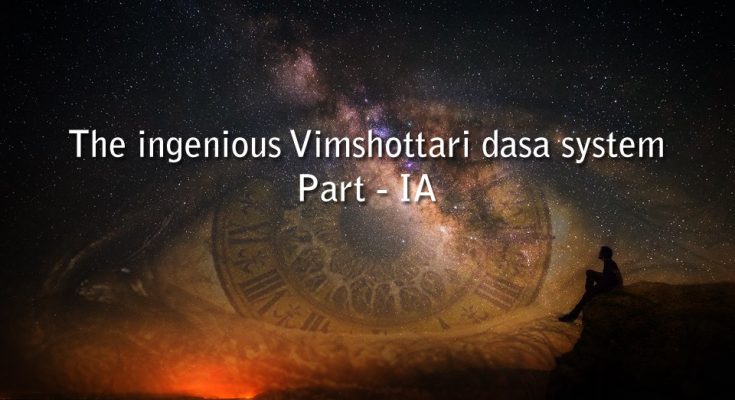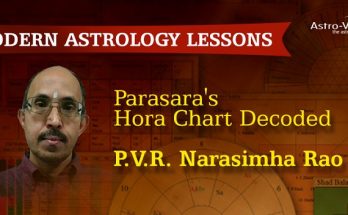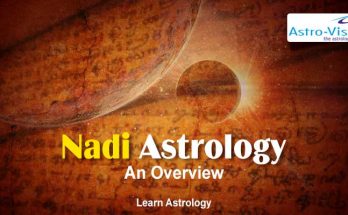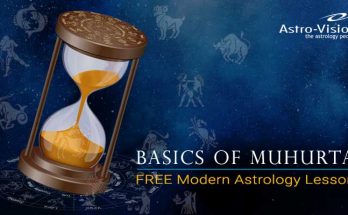Origin in Surya Siddanta
The Hindu Zodiac is based on the ingeniousness of Varahamihira. It appears that later developments in Hora Sastra were totally borrowed from the work of Varahamihira as mentioned in the old Surya Siddhanta or the modern Surya Siddanta. Vimshottari Dasa is also one of them.
Some of the ancient textual premises on which the modern edifice of Indian astrology is built are:-
(i)The oldest division of the Zodiac.
(ii)The Aryabhata system of division of the Zodiac.
(iii)The Varahamihira system of division of the Zodiac.
Oldest Division of Zodiac
The ancient Zodiac was divided into 9 parts and each part consisted of 3 Nakshatras. The arc of each division was 40° 0′. And the Nakshatra series began from Dhanishta . And the rising point (Lagna) was fixed in terms of the Nakshatra and the rising Nakshatra was determined to count from Sravistha (Dhanista). The nine divisions of the ancient the Zodiac are shown in Table I.
Zodiacal Divisions
This division is attributed to sage Satyacharya and was later employed as a predictive tool in Sarvatobhadra Chakra. Varahamihira too has mentioned the name of Satya in the Varaha Jataka (Brihat Jataka). This shows that sage Satyacharya was anterior to Varahamihira. The Hindus calculated all measurements in Tropical years. Let us see the genesis of the tropical Zodiac in the ancient treatise Vedanga Jyotisha of Sage Lagdha, also known as Magdha.
प्रपघेते श्रृविष्टादौ सूर्याचंद्रमसावुदक |
सार्पघे दक्षिणार्कस्तु माघ श्रावणयोः ||
(Vedanga Yajur Jyotisha Sloka 7 )
The purport of this Sloka is that Winter Solstice begins at the beginning of Sravistha (Dhanista) and Summer Solstice in the middle of Aslesha in the months of Magha and Sravana respectively. This Sloka indicates the placement of the Solsticial colure in Aslesha and Dhanista Nakshatras coinciding with the beginning of Dakshinayana and Uttarayana respectively or more precisely Karka Kranti and Makara Kranti. However, it is to be noted that the Sloka nowhere speaks about the entrance of the Sun into either Capricorn sign or Cancer sign as marking the beginning of the Winter Solstice or Summer Solstice. The Sloka presents the actual position of the beginning of the Solstice. This ancient Sloka shows the Hindu measurement of the auspicious day through the Tropical Zodiac.
According to Parasara Samhita,
यघप्राप्तो वैष्णव मुदगमार्ग प्रपघते |
दक्षिणमाश्लेषम वा महाभयय इति ||
When the Sun having reached the end of Sravana in the northern path, he still advances or half of Aslesha in the southern, he still advances, it is a cause of great fear.
According to Vriddha Garga,
यदा निवर्ततते प्राप्तो
धानेष्टामुत्तारणे |
अश्लेषम दक्षिण प्राप्तस्तदा
विन्ध्याम्महृदयं इति ||
When the Sun returns, not having reached Dhanista in the northern solstice, or not having reached Aslesha in the southern, then let a man feel great apprehension of danger.
In both Slokas, Parasara, as well as Vriddha Garga, seem to be confounded with the event which was giving quite contrary results. The Summer Solstice and Winter Solstice were determined with the help of the shadow of the Sun. At both the points of the Solstices, the Sun’s shadow becomes zero and maximum respectively, which implies the beginning of the respective Ayana. The Sun’s shadow used to become zero at the middle of Aslesha at the time of the Vedanga Jyotisha period, which was indicative of the beginning of the Ayana. After that, the Sun’s shadow would increase day by day and reached its maximum length at the beginning of Dhanista Nakshatra or at the end of Sravana Nakshatra.
During the time of Parasara and Vridha Garga, these positions got changed. And they observed that the shadow of the Sun, which should become zero at the middle of Aslesha was still increasing. And the same phenomenon was also taking place at the beginning of Dhanista Nakshatra where it should have become maximum.
This clearly shows that in ancient times the Hindu Zodiac was Tropical, not Sidereal. Had the Hindu Zodiac been Sidereal, Parasara, as well as Garga, would have not written these Slokas and both would have been content with the entry of the Sun into Cancer sign as marking the beginning of the Summer Solstice. But both did not recognize the Sidereal entry of the Sun either into Cancer or Capricorn as the beginning of the respective Ayana.
Courtesy: Modern Astrology(Dr. Arastu Prabhakar, MSc., MBA, Ph.D.) to be continued…










One Comment on “The Ingenious Vimshottari Dasa System – Part IA”